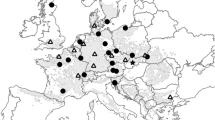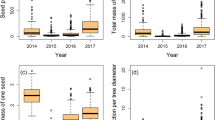Abstract
Prosopis flexuosa is an arboreal Leguminosae that grows in arid and semiarid temperate zones of Argentina, in the Monte eco-region. It is a promising native forest species for recovering arid and semiarid regions because it plays an important role in erosion control as well as in soil fertility. Furthermore, it provides diverse economical resources. The main challenge to the forestry sector is finding a balance between production and forest protection. For this purpose, it is necessary to gather information about genetic parameters. In this study, we measured the distribution of the variation of 14 quantitative traits in an experimental half-sib stand, where families are representative of hierarchically structured populations. We applied a multivariate extension of the classical Q ST –F ST neutrality test to determine the relative importance of drift versus selection in the distribution of genetic variability. We found strong evidence that different selective regimes act on different traits and that selection favors different optima in each sampling site. The selection to different optima is much stronger among than within provenances. This result helps explain the possible causes for the regional variation observed in P. flexuosa and to define the management units and the evolutionarily significant units for this species.



Similar content being viewed by others
References
Acosta M, Oliva L, Abril A (1994) Colección de Rhizobios de Prosopis arbóreos en la zona semiárida de la provincia de Córdoba (Argentina). Ciencia del Suelo 12:38–40
Alvarez JA, Villagra PE (2009) Prosopis flexuosa D.C (Fabeaceae, mimosoideade). Kurtziana 35(1):47–61
Bassam BJ, Caetano-Anollés G, Greshoff PM (1991) Fast and sensitive silver staining of DNA in polyacrylamide gels. Anal Biochem 196:81–84
Benjamini Y, Hochberg Y (1995) Controlling the false discovery rate: a practical and powerful approach to multiple testing. J R Stat Soc Ser B 57:289–300
Bessega C, Ferreyra L, Julio N, Montoya S, Saidman BO, Vilardi JC (2000a) Mating system parameters in species of genus Prosopis (Leguminosae). Hereditas 132(1):19–27
Bessega C, Ferreyra L, Vilardi JC, Saidman BO (2000b) Unexpected low genetic differentiation among allopatric species of section Algarobia of Prosopis (Leguminosae). Genetica 109:255–266
Bessega C, Saidman BO, Darquier MR, Ewens M, Sánchez L, Rozenberg P, Vilardi JC (2009) Consistency between marker and genealogy-based heritability estimates in an experimental stand of Prosopis alba (Leguminosae). Am J Bot 96:458–465
Bessega C, Saidman BO, Darquier MR, Ewens M, Felker P, Vilardi JC (2010) Accuracy of dominant markers for estimation of relatedness and heritability in an experimental stand of Prosopis alba (Leguminosae). Tree Genet Genome 7:103–115
Bessega C, Pometti CL, Ewens M, Saidman BO, Vilardi JC (2011) Strategies for conservation for disturbed Prosopis alba (Leguminosae, Mimosoidae) forests based on mating system and pollen dispersal parameters. Tree Genet Genome. doi:10.1007/s11295-011-0439-6
Black WC IV (1996) Fortran programs for the analysis of RAPD-PCR markers in populations. Colorado State University, Ft. Collins, CO
Box GEP, Cox DR (1964) An analysis of transformations (with discussion). J R Stat Soc Ser B 26:211–252
Brizuela MM, Burghardt AD, Tanoni D, Palacios RA (2000) Estudio de la variación morfológica de Prosopis flexuosa en tres procedencias y su manifestación en cultivos bajo condiciones uniformes. Multequina 9:07–15
Burghardt AD, Espert SM, Braun-Wilke SH (2004) Variabilidad genética en Prosopis ferox (Mimosaceae). Darviniana 42(1–4):31–36
Burkart A (1976) A monograph of the genus Prosopis. J Arn Arb 57: 3–4
Burkart R, BarbaroN, Sánchez RO, Gómez DA (1999) Ecorregiones de la Argentina. Administración de Parques Nacionales PRODIA
Chapuis E, Martin G, Goudet J (2008) Effects of selection and drift on G matrix evolution in a heterogeneous environment: a multivariate Q st–F st test with the freshwater snail Galba truncatula. Genetics 180:2151–2161
Chenoweth SF, Blows MW (2008) Qst meets the G matrix: the dimensionality of adaptive divergence in multiple correlated quantitative traits. Evolution 62:1437–1449
Chessel D, Dufour AB, Thioulouse J (2004) The ade4 package-I—one-table methods. R News 4:5–10
Cony MA (1996) Genetic variability in Prosopis flexuosa D.C. a native tree of Monte phytogeography province, Argentina. For Ecol Manage 87:41–49
Cony MA (1993) Programa de consetvaci6n y mejoramiento de especies de1 genera Prosopis en la Provincia Fitogeografica del Monte, Argentina. In: Contibuciones Mendocinas a la Quinta Reunion Regional para America Latina y el Caribe, de la Red de Forestaci0n de1 CIID. Unidades de Botanica y Fisiologia Vegetal, IADIZA, pp. 37–72
R Development Core Team (2011) R: a language and environment for statistical computing. R Foundation for Statistical Computing: Vienna, Austria. ISBN 3-900051-07-0. Available from: http://www.R-project.org
Dray S, Dufour AB (2007) The ade4 package: implementing the duality diagram for ecologists. J Stat Softw 22(4):1–20
Dray S, Dufour AB, Chessel D (2007) The ade4 package-II: two-table and K-table methods. R News 7(2):47–52
Edelaar P, Burraco P, Gomez-Mestre I (2011) Comparison between Q ST and F ST—how wrong have we been? Mol Ecol 2:4830–4839
Excoffier L, Smouse PE, Quattro JM (1992) Analysis of molecular variance inferred from metric distances among DNA haplotypes: application to human mitochondrial DNA restriction data. Genetics 131:479–491
Falconer DS, Mackay TFC (1989) Introduction to quantitative genetics, 3rd edn. Longman, Harlow, UK
FAO, FLD, IPGRI (2004) Forest genetic resources conservation and management vol. 1: overview, concepts and some systematic approaches. International Plant Genetic Resources Institute, Rome, Italy
Goudet J (2005) Hierfstat, a package for R to compute and test hierarchical F statistics. Mol Ecol Notes 5:184–186. http://www.unil.ch/popgen/softwares/hierfstat.htm
Hamrick JL (2004) Response of forest trees to global environmental changes. For Ecol Manage 197:323–335
Hartl DL, Clark AG (1989) Principles of population genetics. Sinauer, Sunderland, MA
Hedrick PW (2000) Genetics of populations (2nd edn). Jones and Bartlett Publishers, Sudbury, MA
Kimura M (1983) The neutral theory of molecular evolution. Evolution of Genes and Proteins Sinauer, Sunderland, MA
Kruuk LEB (2004) Estimating genetic parameters in natural populations using the ‘animal model’. Philos Trans R Soc Lond B Biol Sci 359:873–890
Lande R (1992) Neutral theory of quantitative genetic variance in an island model with local extinction and colonization. Evolution 46:381–389
Lande R, Arnold SJ (1983) The measurement of selection on correlated characters. Evolution 37:1210–1226
Leinonen T, O’Hara RB, Cano JM, Merilä J (2008) Comparative studies of quantitative trait and neutral marker divergence: a meta-analysis. J Evol Biol 21:1–17
Lopez-Fanjul C, Fernandez A, Toro MA (2007) The effect of dominance on the use of the Q ST −F ST contrasts to detect natural selection on quantitative traits. Genetics 176:725–727
Lynch M, Walsh B (1998) Genetics and analyses of quantitative traits. Sinauer, Sunderland, MA
Mantován NG (2002) Early growth differentiation among Prosopis flexuosa D.C provenances from the Monte phytogeographic province, Argentina. New For 23:19–30
Martin G, Chapuis E, Goudet J (2008) Multivariate Q ST –F ST comparisons: a neutrality test for the evolution of the G matrix in structured populations. Genetics 180:2135–2149
Mc Guigan K (2006) Studying phenotypic evolution using multivariate quantitative genetics. Mol Ecol 15:883–896
Merilä J, Crnokrak P (2001) Comparison of genetic differentiation at marker loci and quantitative traits. J Evol Biol 14:892–903
Morello J, Crudelli N, Saraceno M (1971) Los vinalares de Formosa, República Argentina. Serie Fitogeográfica Nº 11. INTA. Pp. 111
Moritz C (1994) Defining ‘evolutionarily significant units’ for conservation. Tree 9:373–375
Nagylaki T (1998) Fixation indices in subdivided populations. Genetics 148:1325–1332
Nei M (1987) Molecular evolutionary genetics. Columbia University Press, New York
O’Hara RB, Merilä J (2005) Bias and precision in QST estimates: problems and some solutions. Genetics 171:1331–1339
Otha T (1982) Linkage disequilibrium due to random genetic drift in finite subdivided populations. Proc Natl Acad Sci 79:1940–1944
Ovaskainen O, Karhunrn M, Zheng CH, Cano Arias JM, Merilä J (2011) A new method to uncover signatures of divergent and stabilizing selection in quantitative traits. Genetics 189:621–632
Palacios RA, Bravo LD (1981) Hibridación natural en Prosopis (Leguminosae) en la Región Chaqueña Argentina. Evidencias morfológicas y cromatográficas. Darwiniana 23:3–35
Pinheiro J, Bates D, DebRoy S, Sarkar D, the R Development Core Team (2011) nlme: Linear and Nonlinear Mixed Effects Models. R Package
Reed DH, Frankham R (2001) How closely correlated are molecular and quantitative measures of genetic variation? A meta-analysis. Evolution 55(6):1095–1103
Rogers AR (1986) Population differences in quantitative characters as opposed to gene frequencies. Am Nat 127:729–730
Roig FA (1993) Aportes a la Etnobotánica del Género Prosopis. In: Unidades de Botánica y Fisiología vegetal, IADIZA (eds) Contribuciones Mendocinas a la quinta Reunión Regional para América Latina y el Caribe de la Red de Forestación del CIID. pp. 99–121
Sæether SA, Fiske P, Kalas JA, Kuresoo A, Luiguoe L, Piertney SA, Sahlaman T, Höglund J (2007) Inferring local adaptation from Q ST –F ST comparisons: neutral genetic and quantitative trait variation in European populations of great snipe. J Evol Biol 20:1563–1576
Saidman BO, Vilardi JC (1987) Analysis of the genetic similarities among seven species of Prosopis (Leguminosae: Mimosoideae). Theoretical App Genet 75:109–116
Saidman BO, Vilardi JC, Pocovi MI, Acreche N (1996) Genetic divergence among species of the section Strombocarpa genus Prosopis (Leguminosae). J Genet 75:139–149
Saidman BO, Vilardi JC, Montoya S, Dieguez MJ, Hopp HE (1998a) Molecular markers: a tool for the understanding of the relationships among species of Prosopis (Leguminosae, Mimosoidae). In: Puri S (ed) Tree improvement: applied research and technology transfer. Science Publishers Inc, U. S. A, pp 311–324, Ch 21
Saidman BO, Bessega C, Ferreyra L, Vilardi JC (1998b) Random amplified polymorphic DNA (RAPDS) variation in hybrid swarms and pure populations of genus Prosopis. In: Bruns S, Mantell S, Tragärdh C, Viana AV (eds) Recent advances in biotechnology for tree conservation and management. International Foundation for Sciences, Stockholm, pp 122–134, ISBN: 91 85798 460
Schluter D (1996) Adaptive radiation along genetic lines of least resistance. Evolution 50:1766–1774
Spitze K (1993) Population structure in Daphnia obtusa: quantitative genetic and allozymic variation. Genetics 135:367–374
Stean DA, Conod N, Jones RC, Vaillancourt RE, Potts BM (2006) A comparative analysis of population structure of forest tree, Eucaliptus globules (Myrtaceae), using microsatellite markers and quantitative traits. Tree Genet Genome 2:30–38
Templeton AR (1989) The meaning of species and speciation: a genetic perspective. In: Otte D, Endler JA (eds) Speciation and its consequences. Sinauer Associates Inc, Sunderland, Massachusetts, pp 3–27
Trevor P, Schluter D (1991) On the low heritability of life-history traits. Evolution 45(4):853–861
Vekemans X (2002) AFLP-SURV version 1.0. Distributed by the author. Laboratoire de Génétique et Ecologie Végétale, Université Libre de Bruxelles, Belgium
Venables WN, Ripley BD (2002) Modern applied statistics with S, Fourthth edn. Springer, New York, ISBN 0-387-95457-0
Verga A, Mottura M, Melchiorre M, Jouseau J, Carranza C, Ledesma M, Recalde D, Tomalino L, Mendoza S, Vega R (2005) El Proyecto Algarrobo del INTA IDIA XXI(8):195–200
Verga A, López Lauenstein D, López C, Navall M, Joseau J, Gómez C, Royo O, Degano W, Marcó M (2009) Caracterización morfológica de los algarrobos (Prosopis sp.) en las regiones fitogeográficas Chaqueña y Espinal norte de Argentina. Quebracho 17(1,2):31–40
Wright S (1951) The genetic structure of populations. Annu Eugenics 15:323–354
Zhivotovsky LA (1999) Estimating population structure in diploids with multilocus dominant DNA markers. Mol Ecol 8(6):907–913
Zietkiewicz E, Rafalski A, Labuda D (1994) Genome fingerprinting by simple sequence repeat (SSR)-anchored polymerase chain reaction amplification. Genomics 20:176–183
Acknowledgments
This research was supported by funding from Consejo Nacional de Investigaciones Científicas y Técnicas (CONICET) PIP 11220090100147 and Universidad de Buenos Aires (EX 201 and 20020100100008) given to JCV and BOS.
Ethical standards
In order to fulfill the objectives proposed, the experiments conducted comply with the current Argentine laws, and all the trials were made without disturbing the natural ecosystem taking into consideration the current legislation in the country. For the experimental laboratory practice, done at Facultad de Ciencias Exactas y Naturales (Universidad de Buenos Aires), we followed the recommendations from Servicio de Higiene y Seguridad (SHyS, FCEyN, UBA).
Conflict of interest
The authors declare that they have no conflict of interests.
Author information
Authors and Affiliations
Corresponding author
Additional information
Communicated by A. Kremer
Rights and permissions
About this article
Cite this article
Darquier, M.R., Bessega, C.F., Cony, M. et al. Evidence of heterogeneous selection on quantitative traits of Prosopis flexuosa (Leguminosae) from multivariate Q ST –F ST test. Tree Genetics & Genomes 9, 307–320 (2013). https://doi.org/10.1007/s11295-012-0556-x
Received:
Revised:
Accepted:
Published:
Issue Date:
DOI: https://doi.org/10.1007/s11295-012-0556-x




